Key takeaways:
- Religious education promotes critical thinking and empathy by connecting historical events to modern dilemmas.
- Supporting students through encouragement and safe spaces fosters exploration of their beliefs and enhances their confidence.
- Identifying struggling students involves observing non-verbal cues and facilitating open dialogue to address their needs.
- Incorporating faith into learning through personal experiences and creative assessments nurtures spiritual growth and engagement.

Understanding Religious Education
Religious education can sometimes feel like an overwhelming subject, but at its core, it is about understanding the beliefs and practices that shape our world. I remember a moment in class when a student, confused by the diversity of faiths, asked, “Why do people believe different things?” This simple question opened a dialogue that revealed how interconnected our beliefs can be, leading to rich discussions about shared values and differences across cultures.
When students grasp the significance of their lessons, it often transforms their perspective. I once had a student who initially viewed his religious studies as a chore. However, once he connected historical events to modern dilemmas, he became engaged, realizing that these teachings had real implications for understanding humanity. This illustrates how religious education isn’t just about memorizing doctrines; it’s about fostering critical thinking and empathy.
Exploring religion also allows us to reflect on our own beliefs and values. Have you ever considered how your upbringing or community shaped your views? For me, engaging with students about their experiences made me reflect on my own faith journey. This mutual exploration creates a learning environment where both students and educators grow together, deepening our understanding of ourselves and others in the process.
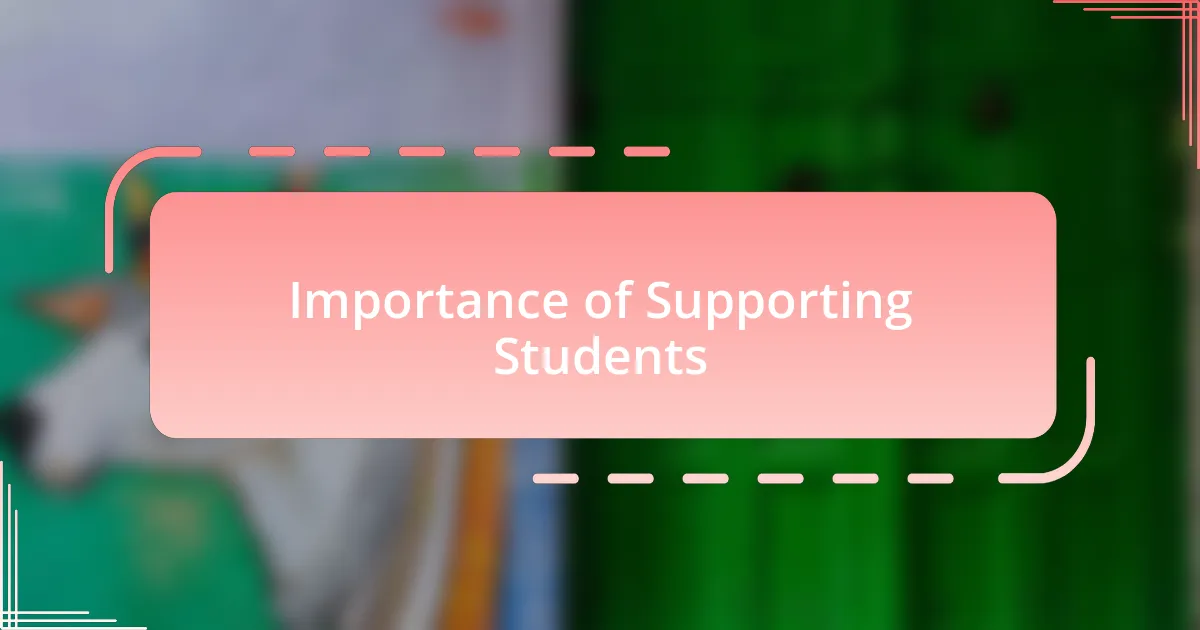
Importance of Supporting Students
Supporting students is crucial because it creates a nurturing environment where they feel valued and understood. I remember a particularly shy student who struggled to participate in discussions about faith. By providing her with encouragement and creating safe spaces for dialogue, I saw her blossom, gaining confidence and sharing her unique insights. This transformation highlighted how vital support is for unlocking a student’s potential.
Furthermore, when we support students, we empower them to explore and question their beliefs. One time, a student expressed doubts about teachings that conflicted with his personal experiences. Instead of dismissing his concerns, I welcomed them and facilitated an open conversation. This not only validated his feelings but also allowed others to grapple with similar questions, fostering a sense of community and shared inquiry. Isn’t it fascinating how the right support can inspire profound exploration of spirituality?
Ultimately, supporting students acknowledges their individuality and unique experiences. It all comes down to creating authentic connections. I once had a student who felt disconnected from religious teachings due to his life on the streets. By relating the lessons to his own experiences, I helped him find a sense of belonging in our discussions. This moment underscored how essential it is to adapt our approach to meet students where they are, transforming their learning experience into something truly impactful.
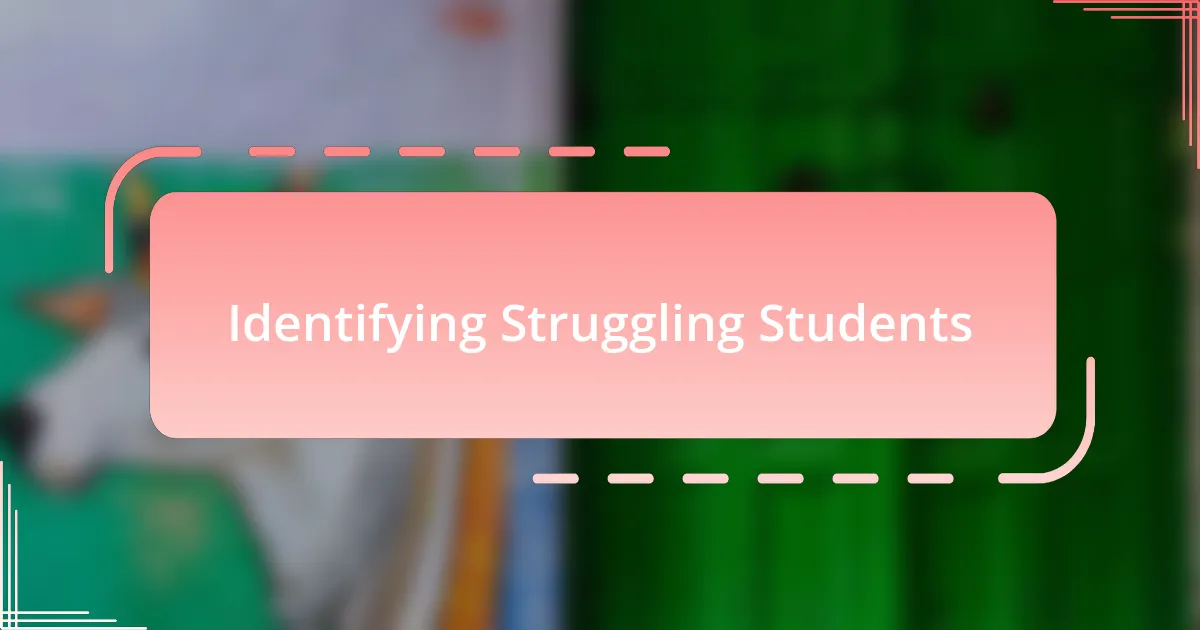
Identifying Struggling Students
When it comes to identifying struggling students, subtle cues can often speak volumes. I recall a student who sat silently at the back of the class, his eyes downcast. Despite his apparent disengagement, his body language hinted at an internal struggle. I learned the importance of observing these non-verbal signals, which often reveal what a child might not be ready to express in words.
Additionally, open dialogue can be a powerful tool for uncovering difficulties. I once initiated one-on-one check-ins with students, allowing them to share their thoughts in a more intimate setting. During one such conversation, a student revealed her confusion over a key concept in our lessons. By creating a space where she felt comfortable voicing her struggles, I was able to identify and address her needs directly, leading to a more meaningful understanding of the material.
Moreover, I’m often reminded that academic challenges are intertwined with emotional well-being. I’ve noticed that students struggling with their faith-related topics might also exhibit signs of anxiety or frustration. In one case, a student who excelled academically started to withdraw when discussions turned spiritual. Recognizing this disconnect helped me intervene early, providing him with the support he needed to navigate his feelings and re-engage with the material. How often do we overlook the emotional context behind a student’s academic performance?
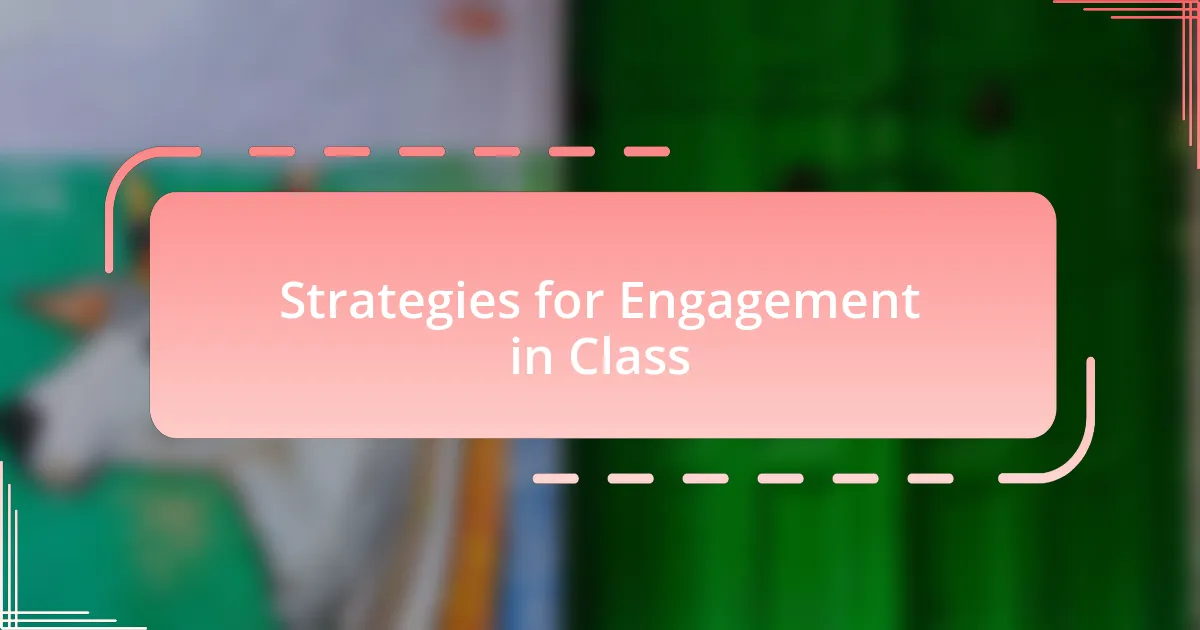
Strategies for Engagement in Class
To foster engagement in class, I found that incorporating interactive activities is incredibly effective. One time, I introduced a group project centered around a religious study that required students to actively collaborate. Watching their eyes light up as they shared ideas made me realize that hands-on experiences not only deepened their understanding but also strengthened their connections with one another. Isn’t it fascinating how collaboration can shift the dynamics in a classroom?
Another strategy I adopted was integrating technology into lessons. I remember using a digital platform where students could anonymously respond to questions during discussions. This method opened the floor for quieter students who might shy away from speaking up. I was pleasantly surprised at how eager they were to express their thoughts when they knew it was a safe space. It prompts me to ask: how can we better use technology to amplify student voices in religious education?
Additionally, relating the coursework to real-life experiences can be a game-changer. I once shared a personal story about a moral dilemma I faced, and it sparked a meaningful discussion among my students. They began to connect the theoretical concepts to their own lives, which not only enhanced their engagement but also allowed them to explore their beliefs more deeply. How often do we draw upon our experiences to bridge the gap between theory and practice?
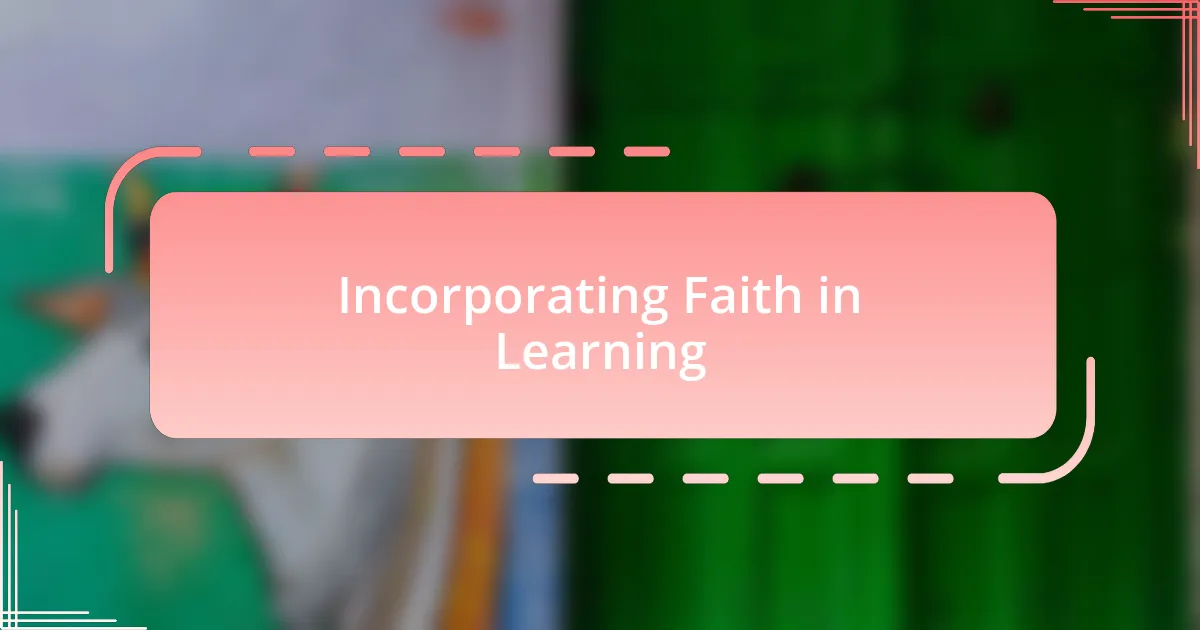
Incorporating Faith in Learning
In my experience, weaving faith into the fabric of learning creates a unique environment where students feel valued. I recall a lesson where we examined religious texts alongside modern ethical dilemmas. The insights students shared were nothing short of inspiring, revealing how their beliefs shaped their perspectives. It made me wonder, can faith-based discussions empower students to be more reflective in their everyday lives?
I also discovered that moments of shared prayer or reflection can set a profound tone for learning. One day, I invited my students to participate in a brief meditation session that emphasized gratitude. The shift in energy was palpable; students seemed more present and engaged throughout the lesson. Seeing their faces light up as they expressed what they were thankful for made me think: could these moments of pause and reflection pave the way for deeper connections with their faith?
Moreover, I’ve found that integrating faith into assessments can encourage students to express their understanding creatively. For instance, I once assigned a project where students illustrated their personal beliefs visually, blending art with their understanding of spiritual concepts. The resulting artwork was a beautiful testament to how faith can inspire creativity. It left me pondering: how can we continuously design assessments that not only test knowledge but also nurture students’ spiritual growth?
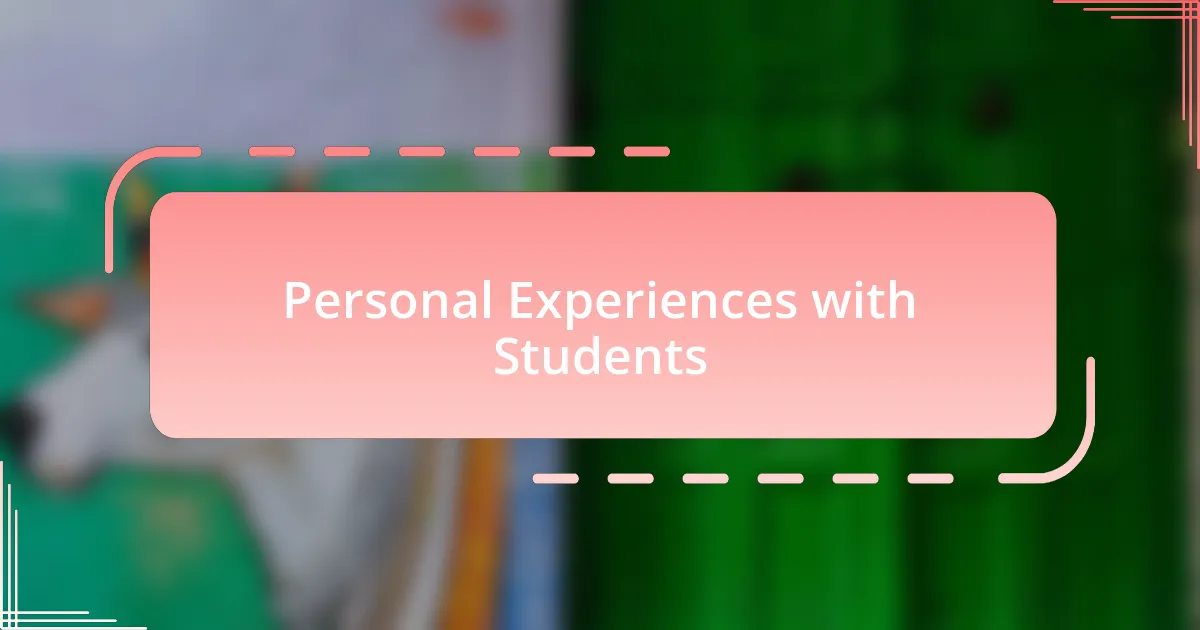
Personal Experiences with Students
Working with students who struggle often unveils moments of connection that are truly rewarding. For instance, I remember a student who had difficulty articulating his thoughts in class discussions. One day, after a particularly challenging session, I asked him to share his ideas one-on-one. As we talked, I could see his face light up when he finally found the right words to express how faith guided him through tough decisions. It struck me how important it is to create safe spaces where students can explore their beliefs without fear of judgment.
Another experience stands out in my memory: a group project where students were tasked with exploring stories of compassion from various faith traditions. One group, which included several shy students, initially hesitated to present. However, when they started discussing how these stories personally resonated with their lives, I could feel their nervousness wash away. Their passion began to shine through, and it made me think—how often do we underestimate the power of storytelling in bridging gaps between students and their experiences?
Additionally, there was a moment with a young girl who constantly doubted her abilities. She approached me after class, expressing feelings of inadequacy in understanding certain spiritual teachings. We spent some time discussing her struggles and identifying small victories in her journey. By the end of our conversation, her eyes sparkled with newfound motivation. It made me realize: how crucial is it to recognize and celebrate incremental growth in our students?
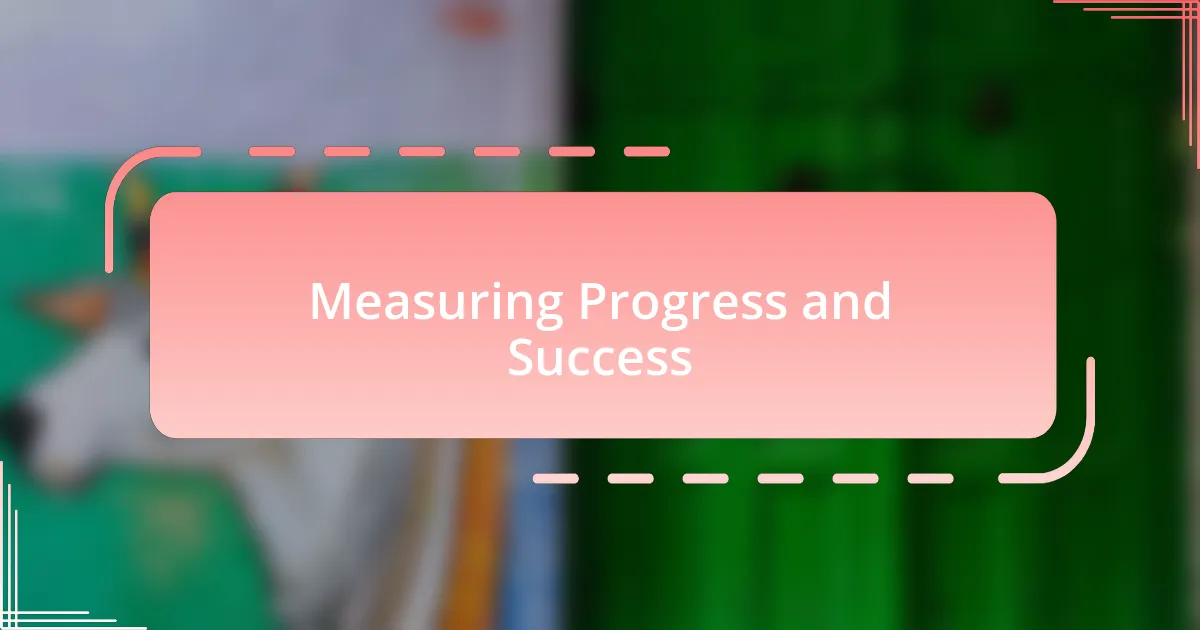
Measuring Progress and Success
Measuring progress with struggling students can be both an enlightening and emotional journey. I recall a particular instance with a student who consistently struggled with reading texts from various religious sources. To assess his growth, I asked him to summarize one of the passages we had discussed. When he presented his summary, the pride in his voice was palpable. It made me reflect: how often do we celebrate the small milestones that lead to greater understanding?
Another effective method I found was using reflective journals to track changes in my students’ thought processes. I introduced this approach to a class of hesitant writers. At first, their entries were sparse and hesitant, but over time, I noticed their writing began to flow more freely. I still remember the day one student expressed her understanding of grace by drawing parallels between her life and a biblical story, showcasing a significant leap in her comprehension. Isn’t it fascinating how self-expression can provide such clarity in measuring growth?
Lastly, I believe in the power of peer feedback as a tool for evaluating success. I’ve seen students who once felt invisible transform through constructive dialogues with their classmates. An instance that stands out was during a group discussion about ethical dilemmas in different faiths. The exchange of ideas helped one student articulate her viewpoints confidently for the first time. It made me think – what if we shifted our focus from merely assessing knowledge to fostering collaborative growth instead?